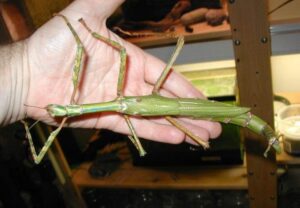Goliath Stick Insect (Eurycnema goliath)
Updated on
17/11/2022The goliath stick insect is a giant stick insect living in Australia. English zoologist George Robert Gray first described this insect in 1834, with its common name referencing the biblical character Goliath due to its impressive size.
Scientific Classification
- Class:Insecta
- Order:Phasmatodea
- Family:Phasmatidae
- Genus:Eurycnema
- Species:E. goliath
Conservation Status
Description
They are among the largest species of stick insects in Australia. Male goliath stick insects are 4.13-5.74 inches, while females are 6.1-8 inches long. They are a bright green-apple color, with yellow bands on the upper part of the stick insect’s body. It has long legs, a thick and flexible abdomen, and large wings. The forewings have the same color as the rest of the insects’ bodies, while the hindwings are transparent. Due to their smaller bodies, males are better at flying than females.
Other Common Names: Regal stick insect
Distribution: Australia, primarily New South Wales and southern Queensland but also in northern Queensland and Tasmania
Habitat: Bushland, gardens, parks, and rainforests
Do they bite: No
Lifespan: 6-7 months
Predator: Birds like the Pacific baza and the pheasant coucal
Behavior and Characteristics
Feeding
As a folivorous species, these insects feed on the leaves of plants of the genus Acacia and Eucalyptus. They are nocturnal feeders. Adults will feed on ten medium-sized leaves, while nymphs eat tender, growing leaves.
Defensive
Goliath stick insects employ passive camouflage due to looking like a leaf or a branch. If predators still approach, they make a “swooshing” sound by rubbing their wings and striking their hind legs together to startle them. This is called deimatic behavior, performed to distract a predator.
Another exciting thing the goliath stick insect does to ward off predators is flick away its frass to throw them off the scent.
Competitiveness
Female goliath stick insects will sometimes fatally injure each other while fighting. Males do not display this behavior.
Life Cycle
This stick insect undergoes incomplete metamorphosis. Females can lay unfertilized eggs but also lay fertilized eggs after sexual reproduction.
1. Egg Stage
Eggs are dark brown, oval-shaped, and resemble plant seeds from Banksia species.
In the wild, females lay eggs from summer through autumn, hatching eggs in 1-2 years. She disperses the egg outwards to the ground using her abdomen. The number of eggs varies based on seasonal conditions and food abundance, with records of 200–800 eggs.
The egg’s edible fleshy structure, similar to elaiosomes in plant seeds, attracts ants to collect and disperse eggs. Ants bring the egg into nests, protecting it from the environment and predation. The green-head ant has been seen doing this.
2. Nymph Stage
The nymph goes through five instars, with molting occurring between each stage and the size increasing consistently until the fifth stage. They usually hatch at night and instinctually climb nearby trees. The first instar is dark brown and has a slender body and legs, prominent cerci, and short antennae. After the second molt, it changes from dark brown to a mottled greyish brown. Following the third molt, sexual dimorphism becomes more prominent, with females developing bigger bodies and males growing longer antennae. After the fourth molt, spine development in the legs increases. In the fifth and final nymphal molt, wings will grow considerably. The final molt takes over an hour, with the stick insect developing a bright apple-green coloration.
Pet Care Sheet
It is popular with kids, with eggs and nymphs being traded worldwide. The goliath stick insect is a common sight in zoos and laboratories.
Enclosure: 35.4 inches high, 15.74 inches deep, and 17.71 inches wide, preferably with a roof of mesh and walls of glass.
Temperature: A heat lamp and a thermostat should be present to ensure that the enclosure remains slightly above room temperature.
Humidity: Proper ventilation must be present so the eggs can hatch.
Feeding: Their diet in captivity consists of bramble, hawthorn, oak, and firethorn.
Substrate: Leaf litter is a preferred substrate in a stick insect enclosure.
Source
sunnycoastmedia.com.au, phasmidstudygroup.org, ourbreathingplanet.com, zoochat.com, arovingiwillgo.files.wordpress.com, science.org, scontent.fccu4-2.fna.fbcdn.net















